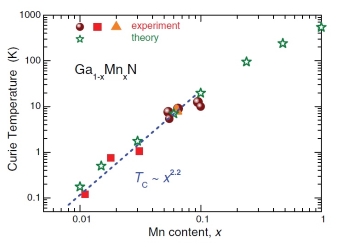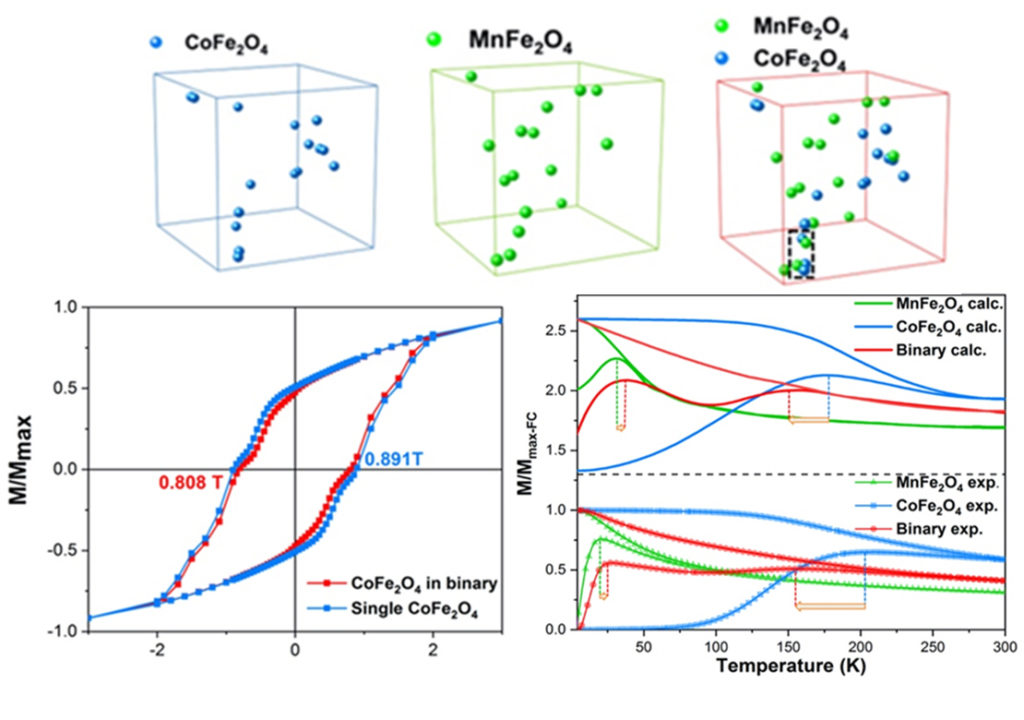Novel Magnetic Nanostructures
1. High-moment and Exchange coupled magnetic nanostructures
In this activity magnetic nanostructures that consist of two or more different constituents which can be of ferromagnetic (Co, Fe), antiferromagnetic (CoO, Mn) , ferrimagnetic (spinel ferrites) or spin-glass like phases with an extra unidirectional anisotropy along the interface of the magnetic materials are investigated. These nanostructures can combine very small size of their constituents and enhanced macroscopic magnetic properties as such they find a variety of technological applications as sensors, biosensors, microwave devices, magnetic recording devices. Our calculations include simulations in an atomic scale for single nanoparticles and a mesoscopic scaling approach developed in our group for the study of assemblies of nanoparticles.
Selected Publications
Interplay between inter- and intra-particle interactions in bi-magnetic core/shell nanoparticles
Nanoscale Advances 3 (2021) 6912-6924
Monte Carlo study of the superspin glass behavior of interacting ultrasmall ferrimagnetic nanoparticles
Physical Review B 97 (2018) 094413
Robust Ferromagnetism of Chromium Nanoparticles Formed in Superfluid Helium
Adv. Mater. 29 (2017) 1604277
Robust antiferromagnetic coupling in hard-soft bi-magnetic core/shell nanoparticles
Nat. Comm. 4 (2013) 2960

Advanced Materials 24 (2012) 4331
2. Diluted Magnetic Semiconductor Nanostructures (random ferromagnets Ga1-x Mnx N, Cd1-xMnxTe)
The presence of ferromagnetic interactions without band carriers, together with a sizable spin splitting of the excitonic states makes the Ga1−xMnxN and Cd1−xMnxTe systems suitable for magneto-optical devices, such as optical isolators, circumventing the destructive effect of antiferromagnetic interactions specific to II-VI Mn-based dilute magnetic semiconductors. We have employed numerical simulations to study the microscopic mechanisms accounting for the observed alterations of their critical temperatures and hysteresis.

Selected Publications
Phase diagram and critical behavior of the random ferromagnet Ga1 -xMnxN
Phys. Rev. B 88 (R) (2013) 081201
Origin of low-temperature magnetic ordering in Ga 1-xMnxN
Phys. Rev. B 85 (2012 ) 205204
Monte Carlo simulations of ferromagnetism in p-Cd1-xMnxTe quantum wells
Phys. Rev. Lett. 94 (2005) 127201
3. Binary nanoparticle composites
Nanoparticle composite systems are disordered mixtures pursuing a combination of properties to optimize a given figure of merit. Lately, the idea is epitomized by the exchange coupling strategy between magnetically soft and hard nanograins (with high saturation magnetization and large coercivity, respectively) to maximize the energy product of novel permanent magnets. We have studied the collective behaviour of binary nanoparticle composites since understanding the collective versus individual behavior of dense and diluted systems of nanoparticles becomes crucial to optimize their applications.
Selected Publications

Bad neighbour, good neighbour: how magnetic dipole interactions between soft and hard ferrimagnetic nanoparticles affect macroscopic magnetic properties in ferrofluids
Nanoscale 12 (2020) 11222-11231
Simultaneous Individual and Dipolar Collective Properties in Binary Assemblies of Magnetic Nanoparticles